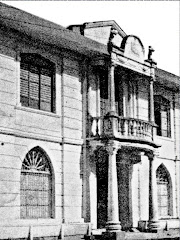Ma Mon Luk Mami
Ed, Ma Mon Luk is not just a memory worth writing in your “Maalaala Mo Kaya” series. It still exists!
Last Friday was a rainy day. In fact, classes were suspended in Manila, although the announcement was made late at usual at around 11 am. I had a 9:30 a.m. meeting somewhere near Malacanang (hindi sa loob, sa tabi-tabi). So I left the house early at 8 am, to make sure I wouldn’t be late. Surprisingly, there was not much traffic and there were no flooded areas where the FX ride that I took passed. The meeting ended around 12:30 pm. From out of the blue, one of our colleagues asked if we wanted to eat hot mami at Ma Mon Luk for lunch on a rainy day. I was happily surprised. I love Ma Mon Luk mami. But until then, I didn’t know that it still exists. The last time I had a taste of its mami was more than ten years ago, when there was a branch along EDSA corner Kamias St. (I think, or at least somewhere in that area). I was informed that the other remaining branch is in Quiapo.
So, riding in two vans, nine of us (including the drivers) proceeded to Quezon Avenue near Banawe St., where the old Ma Mon Luk Restaurant still stands. The space in front of the building, which was already part of the sidewalk was almost filled with cars. It is still the same Chinese restaurant of the olden days. It’s not air conditioned, it’s crowded, a bit dirty, with old tables and chairs, pero napalitan na iyong makakapal na baso with thinner but still similar plain transparent drinking glasses. And there are younger waiters now, but there were still the older ones like Lucio, our waiter. He said that he’s been with Ma Mon Luk since 1978. (O 30 years na siyang waiter, pero mukhang hindi pa rin siya ang head waiter).
We ordered the original mami. I ordered large, but their ‘large’ bowl is no longer as big as before. It’s ‘small’ for my appetite for mami. We also ordered siopao special and siomai. The mami still smelled and tasted the same. Medyo mabantot na medyo mabaho, pero ang sarap. It’s still the best mami for me! The siopao special is big and would really fill your hungry stomach. Masarap pa din, no matter if there were rumors before that na karneng pusa daw ang nilalagay. That was really a good meal that I had last Friday. I’m sure that it wouldn’t be my last in my newly rediscovered Ma Mon Luk!
I looked at the history of Ma Mon Luk and I’m reprinting it below. By the way, I didn’t have my camera and I forgot that my cellphone has a camera, so I was not able to take any shot. Luckily I found pictures from “Ajay’s Writing on the Wall” blog. Thanks.
From Wikipedia
Ma Mon Luk (1896-1961) was a pioneering Chinese Filipino chef and entrepreneur. He established the popular Chinese restaurant that bears his name, Ma Mon Luk.
Born in Guangdong, China, he was a grade school teacher in Guangzhou when he decided to emigrate to the Philippines in 1918. According to legend, he migrated to the Philippines in order to earn his fortune and win the hand of a girl whose wealthy Cantonese family looked none too kindly on his poverty. Arriving penniless in Manila, Ma Mon Luk decided to peddle chicken noodle soup, utilizing egg noodles. He soon became a familiar sight on the streets of Manila, plodding down with a long bamboo pole slung on his shoulders with two metal containers on each end. One vat contained his especially concocted noodles and strips of chicken meat, while the other stored chicken broth heated by live coals underneath. With a pair of scissors, he would cut the noodles and meat to serve to his customers. Among his frequent customers were students from the various schools and universities in Manila, whom he would regale with tales about China. Ma Mon Luk himself called his concoction "gupit", after the Tagalog word for "cut with scissors". A popular theory of the origin of the word "mami" is that "Ma" came from his name and "Mi" came from the Chinese word for "recipe"; thus "mami" stands for "the recipe of Mr. Ma. Soon however, Filipinos took the name as an amalgam of Tagalog words for chicken ("manok") and egg noodles ("miki").
Ma Mon Luk soon opened his first restaurant in Binondo, where he introduced his equally famous siopao, a steamed pork dumpling enhanced by a secret sauce. Ma Mon Luk nonetheless continued to peddle his wares on the streets, advertising his restaurant by giving away free samples. By the 1950s, Ma Mon Luk and his mami were nationally known, and Ma Mon Luk became the iconic Chinese restaurant, sprouting many imitators who failed to equal its success. At one point, in the mid 1990s, there were at least six Ma Mon Luk restaurants in Metro Manila, but as of 2006, only the branches in Quezon Avenue and Quiapo remain open.
Ma Mon Luk died on September 1, 1961 of throat cancer and is buried at the Chinese Cemetery in Manila. He is succeeded to date by 3 generations of Ma Mon Luks.




1 comment:
keep on posting..
Post a Comment